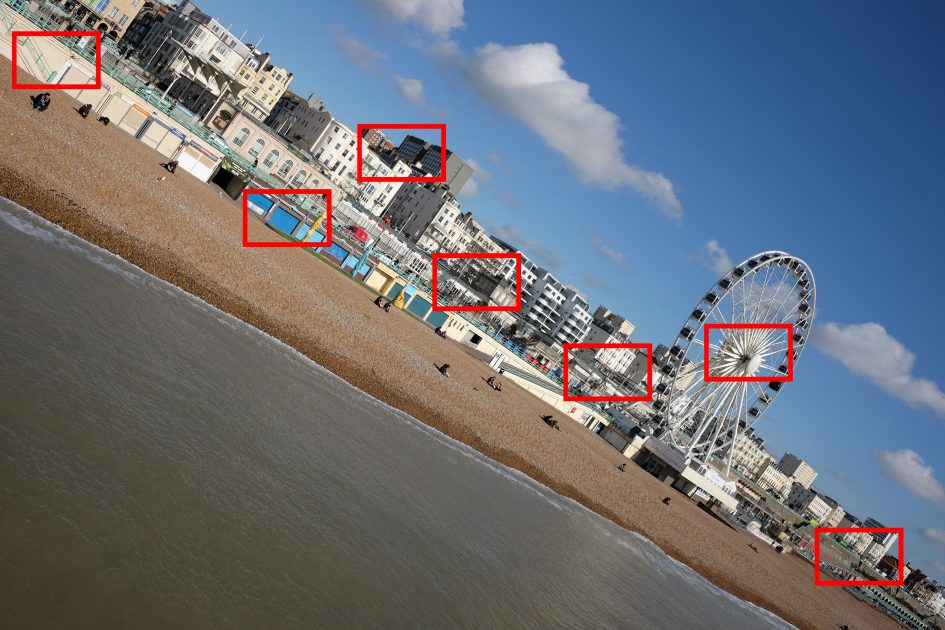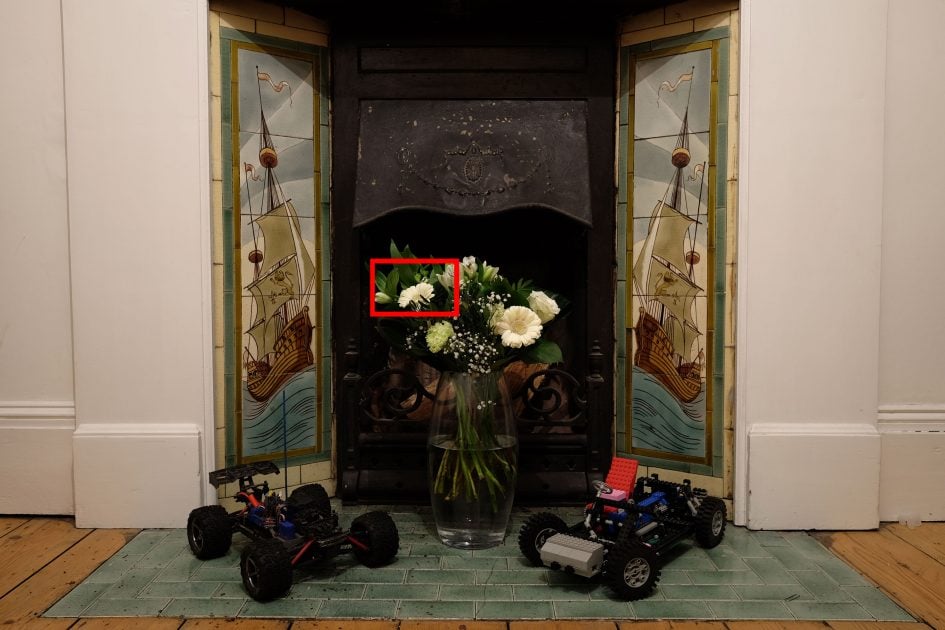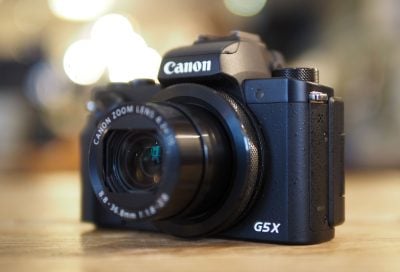Canon PowerShot G5X review
-
-
Written by Gordon Laing
Quality
To compare the real-life quality between the Fujifilm X70 and the Canon PowerShot G5X, I shot this scene with both cameras moments apart, adjusting the G5X’s zoom to match the fixed field-of-view of the X70. Both cameras were set to their respective base sensitivities of 200 and 125 ISO and their optimal apertures of f5.6 and f4. Until both cameras are supported by Adobe Camera RAW, I’m comparing JPEGs here straight-out-of-camera.

In the crops below, you’re comparing the 16 Megapixel APSC sensor and fixed lens of the X70 versus the 20 Megapixel 1in sensor and zoom lens of the G5X. You’d assume the X70 with its fixed lens and larger sensor would out-perform the G5X here, but judging from the crops below, there’s not a great deal between them, at least under bright conditions.
In the extreme corners, the fixed lens on the X70 is a little crisper than the zoom on the G5X, but not by a huge margin. As you move away from the extremes though, you’ll find the slightly higher resolution sensor of the G5X allows it to resolve slightly finer details than the X70, most obviously in grills, gratings and fencing, but again the difference isn’t huge.
In this particular example, both cameras have also processed the scene in a similar style in terms of tone and colour. In my extended tests I feel Fujifilm’s image processing has an overall edge over Canon’s, but I’m certainly not complaining about the look of the G5X images. The bottom line is both cameras are capable of delivering very satisfying results with their default settings, and under bright conditions with few shadows there’s not a great deal to choose between them.

Above left: Fujifilm X70 at f5.6, 200 ISO. Above right: Canon G5X at f4, 125 ISO. 100% crops from JPEGs

Above left: Fujifilm X70 at f5.6, 200 ISO. Above right: Canon G5X at f4, 125 ISO. 100% crops from JPEGs

Above left: Fujifilm X70 at f5.6, 200 ISO. Above right: Canon G5X at f4, 125 ISO. 100% crops from JPEGs

Above left: Fujifilm X70 at f5.6, 200 ISO. Above right: Canon G5X at f4, 125 ISO. 100% crops from JPEGs

Above left: Fujifilm X70 at f5.6, 200 ISO. Above right: Canon G5X at f4, 125 ISO. 100% crops from JPEGs

Above left: Fujifilm X70 at f5.6, 200 ISO. Above right: Canon G5X at f4, 125 ISO. 100% crops from JPEGs

Above left: Fujifilm X70 at f5.6, 200 ISO. Above right: Canon G5X at f4, 125 ISO. 100% crops from JPEGs
But what about in low light? You’d assume the larger sensor and lower resolution of the X70 will allow it to deliver cleaner results at high ISOs and you can find out in my noise results below. Or if you prefer, skip straight to my sample images.
Fujifilm X70 vs Canon PowerShot G5X noise
To compare noise levels under real-life conditions, I shot this scene with the Fujifilm X70 and Canon PowerShot G5X at each of their ISO values. The full view is pictured below with the red rectangle indicating the area I cropped; note I’m comparing out-of-camera JPEGs here until both models are supported by Adobe Camera RAW.

Here we’re comparing the 16 Megapixel APSC sensor of the Fujifilm X70 against the 20 Megapixel 1in sensor of the Canon G5X. Since the Canon packs more pixels into a smaller surface area you’d expect it to become noisier at higher sensitivities compared to the Fujifilm, so let’s look at the crops below to find out.
Judging from the crops below, I’d say the X70 enjoys an advantage from the get-go where, even at their lowest sensitivities, the Fujifilm is recording greater tonal details, most obviously in the dark patterns on the leafs. Just look at the leaf in the upper middle of the crops at 400 and 800 ISO and you’ll see almost all surface detail has been erased from the Canon, but veins and ridges remain visible on the Fuji.
Then at 1600 ISO, the G5X becomes gradually softer than the X70, and at 3200 ISO, noticeably noisier too. Indeed I’d say the Fujifilm X70 enjoys an advantage of around two to three stops over the Canon G5X which makes sense given its larger sensor and lower resolution.
But comparing the crops side-by-side isn’t necessarily a fair reflection of how you’ll use each camera in practice. For starters the Canon G5X lens is just over one stop brighter than the X70, allowing it to deploy a sensitivity one stop slower under the same conditions. The Canon G5X also features optical stabilisation which lets you handhold shutter speeds two to three stops slower than the X70. Now this may not be useful if your subject is in motion – unless you want to deliberately blur it of course – but if your subject is static, it’ll allow you to use even lower ISOs under the same conditions. Indeed when you factor in the brighter lens and stabilisation, the G5X could gain up to four stops over the X70 which is like shooting at 200 ISO on the former and 3200 ISO on the latter. It essentially allows the G5X to claw back much of the X70’s advantage of having a bigger and lower resolution sensor.
So while the X70 visibly out-performs the G5X at matching ISOs, the Canon may well come close to its results if you can fully exploit the brighter lens and optical stabilisation. If you can’t though, the X70 is by far the preferred choice in low light, across the sensitivity range – at low ISOs it’s capturing a far greater tonal range and at high ISOs it’s much less noisy.

Above left: Fujifilm X70 at 100 ISO. Above right: Canon G5X at 125 ISO. 100% crops from JPEGs

Above left: Fujifilm X70 at 200 ISO. Above right: Canon G5X at 200 ISO. 100% crops from JPEGs

Above left: Fujifilm X70 at 400 ISO. Above right: Canon G5X at 400 ISO. 100% crops from JPEGs

Above left: Fujifilm X70 at 800 ISO. Above right: Canon G5X at 800 ISO. 100% crops from JPEGs

Above left: Fujifilm X70 at 1600 ISO. Above right: Canon G5X at 1600 ISO. 100% crops from JPEGs

Above left: Fujifilm X70 at 3200 ISO. Above right: Canon G5X at 3200 ISO. 100% crops from JPEGs

Above left: Fujifilm X70 at 6400 ISO. Above right: Canon G5X at 6400 ISO. 100% crops from JPEGs

Above left: Fujifilm X70 at 12800 ISO. Above right: Canon G5X at 12800 ISO. 100% crops from JPEGs

Above left: Fujifilm X70 at 25600 ISO.

Above left: Fujifilm X70 at 51200 ISO.
Next check out my sample images.




